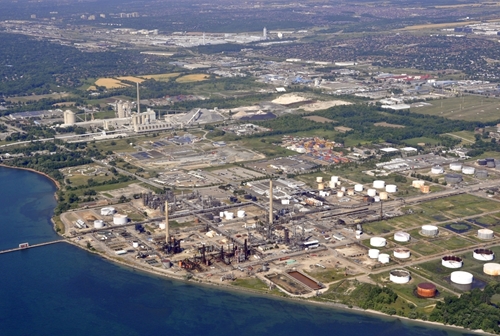What is Polluting the Great Lakes?

![]()
In the U.S., the Great Lakes are renowned for their natural beauty. Outdoor enthusiasts, swimmers and fishermen have all been able to appreciate these bodies of water. However, as industrialization increased in the U.S., so, too, did contamination of the lakes. This pollution is a combination of both airborne chemical compounds as well as effluent waste from factories and other companies located near rivers that feed pollution into the lakes.
In an effort to protect and restore the Great Lakes, 16 federal agencies came together to form the Great Lakes Restoration Initiative in 2010. Between 2011 and 2014, one team of scientists from the University of Rhode Island monitored the progress of the GLRI and continually assessed the health of the lakes. During this time period, they observed that the types of pollutants found in the water shifted from airborne contaminants to chemical compounds that were primarily coming from the land and rivers converging onto the lakes, as presented at the American Geophysical Union in San Francisco.
Restoration is outlined in 5 goals
When the GLRI was established in 2010, its goals divided into two phases. Phase I took place between FY 2010 and FY 2014. The goals of GLRI Phase I were to clean up toxics and areas of concern, fight invasive species, protect watersheds from polluted runoff, restore wetlands and other habitats, and track progress. Phase II of the GLRI, which is scheduled to run from FY 2015 to FY 2019, is essentially an accelerated continuation of these goals.
Within these goals are smaller projects. For example, as part of reducing pollution in runoff, scientists are working to figure out how to prevent contamination with phosphorus. This element promotes algae growth, which potentially contaminates drinking supplies with toxins while depleting the water of oxygen and creating dead zones.
'The lakes are now cleansing themselves'
To understand the severity of the current pollution situation in the Great Lakes, the authors of the study built sampling stations, in which sheets of polyethelene absorbed contaminants, at more than 30 points around Lake Erie and Lake Ontario. Analysis of the chemical compounds helped them determine what kind of pollution was contaminating the lakes, and in what quantities.
The scientists discovered that pollutants from the air, which were a major problem in the past, were not settling on the surface water as much as they had. Meanwhile, levels of persistent legacy pollutants, such as pesticides and PCBs, were also decreasing at most of the lakes, but were still present at certain river outflows.
"Because these pollutants have been banned for such a long time, they're no longer in the atmosphere in high concentrations and so [they] aren't entering the lakes that way," Rainer Lohmann, professor of chemical oceanography at the URI Graduate School of Oceanography, said in a statement. "But we still see evidence of them coming from Superfund sites and old industrial sites. And the lakes are now cleansing themselves by releasing these old pollutants back to the atmosphere."
While there are fewer legacy pollutants, the researchers observed that newer classes of chemical compounds are becoming more prevalent. Specifically, the scientists observed rises in the levels of industrial flame retardants and musks. One reason why musks are problematic is that they do not get broken down at wastewater facilities. Furthermore, because they are found in various fragrances and cosmetics, they tend to be common around urbanized areas.
Research published in the journal Environmental Health Perspectives pointed out that musks are easily retained in fatty tissue. Studies on musks demonstrated that musks can harm mussels by inhibiting their cellular defenses. Furthermore, this study speculated that this process in mussels also makes the animals more vulnerable to the effects of toxics from other sources.
For over 38 years Greyhound Chromatography has been supplying high quality Chromatography consumables to laboratories around the world. Greyhound’s extensive range covers all areas of Environmental, Petrochemical, Food, Forensics, Chemical and Pharmaceutical analysis. Backed by a highly experienced technical services team, Greyhound is the preferred source amongst today’s analysts.
Greyhound Chromatography is proud to supply Chem Service Certified Reference Standards.
CONTACT US
Tel: +44 (0) 151 649 4000
Email: marketing@greyhoundchrom.com
FOLLOW US
YOU MAY ALSO BE INTERESTED IN OUR NEWSLETTER















